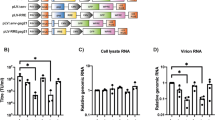Abstract
The development of lentiviral vectors that use Rev-independent mechanisms of nuclear export for their genomic RNA could facilitate the construction of novel anti-HIV vectors. We have improved the titers of Rev-independent lentiviral vectors having the SRV-1 CTE by mutating the major splice donor and acceptor sites present in the vector and by relocalization of the CTE sequences adjacent to the HIV-1 3′LTR. These two modifications have additive beneficial effects on vector titers and packaging efficiency. Packaging these CTE+ vectors expressing marker genes with a Rev-dependent HIV-1 helper vector yields higher titers than are obtained using a Rev-dependent lentiviral vector.
This is a preview of subscription content, access via your institution
Access options
Subscribe to this journal
Receive 12 print issues and online access
$259.00 per year
only $21.58 per issue
Buy this article
- Purchase on Springer Link
- Instant access to full article PDF
Prices may be subject to local taxes which are calculated during checkout




Similar content being viewed by others
References
Poeschla E, Corbeau P, Wong-Staal F . Development of HIV vectors for anti-HIV gene therapy Proc Natl Acad Sci USA 1996 93: 11395–11399
Corbeau P, Wong-Staal F . Anti-HIV effects of HIV vectors Virology 1998 243: 268–274
Dropulic B, Hermankova M, Pitha PM . A conditionally replicating HIV-1 vector interferes with wild-type HIV-1 replication and spread Proc Natl Acad Sci USA 1996 93: 11103–11108
An DS et al. An inducible human immunodeficiency virus type 1 (HIV-1) vector which effectively suppresses HIV-1 replication J Virol 1999 73: 7671–7677
Bukovsky AA, Song JP, Naldini L . Interaction of human immunodeficiency virus-derived vectors with wild-type virus in transduced cells J Virol 1999 73: 7087–7092
Malim MH, Bohnlein S, Hauber J, Cullen BR . Functional dissection of the HIV-1 Rev trans-activator – derivation of a trans-dominant repressor of Rev function Cell 1989 58: 205–214
Ragheb JA et al. Analysis of trans-dominant mutants of the HIV type 1 Rev protein for their ability to inhibit Rev function, HIV type 1 replication, and their use as anti-HIV gene therapeutics AIDS Res Hum Retrovir 1995 11: 1343–1353
Gasmi M et al. Requirements for efficient production and transduction of human immunodeficiency virus type 1-based vectors J Virol 1999 73: 1828–1834
Kim VN, Mitrophanous K, Kingsman SM, Kingsman AJ . Minimal requirement for a lentivirus vector based on human immunodeficiency virus type 1 J Virol 1998 72: 811–816
Srinivasakumar N, Schuening FG . A lentivirus packaging system based on alternative RNA transport mechanisms to express helper and gene transfer vector RNAs and its use to study the requirement of accessory proteins for particle formation and gene delivery J Virol 1999 73: 9589–9598
Srinivasakumar N et al. The effect of viral regulatory protein expression on gene delivery by human immunodeficiency virus type 1 vectors produced in stable packaging cell lines J Virol 1997 71: 5841–5848
Rizvi TA, Schmidt RD, Lew KA, Keeling ME . Rev/RRE-independent Mason–Pfizer monkey virus constitutive transport element-dependent propagation of SIVmac239 vectors using a single round of replication assay Virology 1996 222: 457–463
Zolotukhin AS, Valentin A, Pavlakis GN, Felber BK . Continuous propagation of RRE(−) and Rev(−)RRE(−) human immunodeficiency virus type 1 molecular clones containing a cis-acting element of simian retrovirus type 1 in human peripheral blood lymphocytes J Virol 1994 68: 7944–7952
Mautino MR, Ramsey WJ, Reiser J, Morgan RA . Modified HIV-based lentiviral vectors display decreased sensitivity to transdominant Rev Hum Gene Ther 2000 11: 895–908
Naldini L et al. Efficient transfer, integration, and sustained long-term expression of the transgene in adult rat brains injected with a lentiviral vector Proc Natl Acad Sci USA 1996 93: 11382–11388
Ernst RK, Bray M, Rekosh D, Hammarskjold ML . A structured retroviral RNA element that mediates nucleocytoplasmic export of intron-containing RNA Mol Cell Biol 1997 17: 135–144
Rizvi TA, Schmidt RD, Lew KA . Mason–Pfizer monkey virus (MPMV) constitutive transport element (CTE) functions in a position-dependent manner Virology 1997 236: 118–129
Author information
Authors and Affiliations
Rights and permissions
About this article
Cite this article
Mautino, M., Keiser, N. & Morgan, R. Improved titers of HIV-based lentiviral vectors using the SRV-1 constitutive transport element. Gene Ther 7, 1421–1424 (2000). https://doi.org/10.1038/sj.gt.3301262
Received:
Accepted:
Published:
Issue Date:
DOI: https://doi.org/10.1038/sj.gt.3301262
Keywords
This article is cited by
-
DNA Vectors Generating Engineered Exosomes Potential CTL Vaccine Candidates Against AIDS, Hepatitis B, and Tumors
Molecular Biotechnology (2018)
-
Analysis of human immunodeficiency virus type 1 vector cis- and trans-acting elements production by means of Semliki Forest virus
Gene Therapy (2009)
-
Lentiviral vector design using alternative RNA export elements
Retrovirology (2007)
-
Inhibition of HIV-1 replication by novel lentiviral vectors expressing transdominant Rev and HIV-1 env antisense
Gene Therapy (2002)



